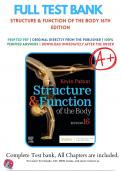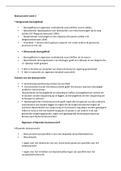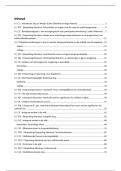Structure & Function of the Body 16th
Edition
PRINTED PDF | ORIGINAL DIRECTLY FROM THE PUBLISHER | 100%
VERIFIED ANSWERS | DOWNLOAD IMMEDIATELY AFTER THE ORDER
Complete Test bank, All Chapters are included.
For more Test banks, ATI, HESI exams, and more contact us.
,Table of content
Chapter 1. Introduction to the body
Chapter 2. Chemistry of life
Chapter 3. Cells
Chapter 4. Tissues
Chapter 5. Organ systems
Chapter 6. Skin and membranes
Chapter 7. Skeletal system
Chapter 8. Muscular system
Chapter 9. Nervous system
Chapter 10. Senses
Chapter 11. Endocrine system
Chapter 12. Blood
Chapter 13. Cardiovascular system
Chapter 14. Lymphatic system and immunity
Chapter 15. Respiratory system
Chapter 16. Digestive system
Chapter 17. Nutrition and metabolism
Chapter 18. Urinary system
Chapter 19. Fluid and electrolyte balance
Chapter 20. Acid-base balance
Chapter 21. Reproductive systems
Chapter 22. Growth, development, and aging
,Chapter 01: Introduction to the Body
Thibodeau & Patton: Structure & Function of the Body, 16th Edition
MULTIPLE CHOICE
1. The word derived from two word parts that mean “cutting apart” is
a. physiology
b. homeostasis
c. anatomy
d. dissection
ANS: C DIF: Memorization REF: p. 3
OBJ: 1 TOP: Introduction
2. The study of how the body functions is called
a. physiology
b. homeostasis
c. anatomy
d. dissection
ANS: A DIF: Memorization REF: p. 3
OBJ: 1 TOP: Introduction
3. The correct sequence of the level of organization is
a. cellular, chemical, tissue, organ
b. chemical, cellular, tissue, organ
c. chemical, cellular, organ, tissue
d. chemical, tissue, cellular, organ
ANS: B DIF: Memorization REF: p. 5
OBJ: 3 TOP: Structural levels of organization
4. The smallest living unit of structure is considered to be at the
a. chemical level
b. cellular level
c. organ level
d. tissue level
ANS: B DIF: Memorization REF: p. 6
OBJ: 3 TOP: Structural levels of organization
5. The reference position for all body directional terms is the
a. anatomical position
b. prone position
c. supine position
d. sitting position
ANS: A DIF: Memorization REF: pp. 6-7
OBJ: 4 TOP: Anatomical position
6. The relationship between the knee and the ankle can be described as
, a. the knee is inferior to the ankle
b. the knee is distal to the ankle
c. the knee is proximal to the ankle
d. both a and b above
ANS: C DIF: Application REF: pp. 7-8 OBJ: 5
TOP: Anatomical directions
7. The relationship between the heart and the lungs can be described as
a. the heart is distal to the lungs
b. the heart is medial to the lungs
c. the heart is lateral to the lungs
d. both a and c above
ANS: B DIF: Application REF: p. 7 OBJ: 5
TOP: Anatomical directions
8. The term most opposite proximal is
a. medial
b. superior
c. anterior
d. distal
ANS: D DIF: Memorization REF: p. 7
OBJ: 5 TOP: Anatomical directions
9. Because humans walk in an upright position, the two terms that can be used interchangeably
are
a. posterior and ventral
b. posterior and inferior
c. posterior and superficial
d. posterior and dorsal
ANS: D DIF: Memorization REF: p. 7
OBJ: 5 TOP: Anatomical directions
10. The term most opposite medial is
a. dorsal
b. lateral
c. superficial
d. none of the above
ANS: B DIF: Memorization REF: p. 7
OBJ: 5 TOP: Anatomical directions
11. The relationship between the skin and the muscles can be described as
a. the skin is superficial to the muscle
b. the muscle is superficial to the skin
c. the muscle is deep to the skin
d. both a and c above
ANS: D DIF: Memorization REF: p. 7
OBJ: 3 TOP: Anatomical directions
,12. A cut dividing the body into anterior and posterior portions is called a
a. sagittal section
b. frontal section
c. transverse section
d. none of the above
ANS: B DIF: Memorization REF: p. 9
OBJ: 5 TOP: Planes or body sections
13. A cut dividing the body into upper and lower portions is called a
a. sagittal section
b. frontal section
c. transverse section
d. coronal section
ANS: C DIF: Memorization REF: p. 9
OBJ: 5 TOP: Planes or body sections
14. A cut dividing the body into right and left portions is called a
a. sagittal section
b. frontal section
c. transverse section
d. coronal section
ANS: A DIF: Memorization REF: pp. 8-9
OBJ: 5 TOP: Planes or body sections
15. The mediastinum is part of the
a. dorsal cavity
b. ventral cavity
c. abdominal cavity
d. both b and c above
ANS: B DIF: Memorization REF: p. 9
OBJ: 6 TOP: Body cavities
16. The two major cavities of the body are the
a. dorsal and ventral
b. thoracic and abdominal
c. pleural and mediastinum
d. none of the above
ANS: A DIF: Memorization REF: p. 9
OBJ: 6 TOP: Body cavities
17. The diaphragm divides the
a. dorsal from the ventral cavity
b. abdominal from the pelvic cavity
c. thoracic from the abdominal cavity
d. pleural from the mediastinum
ANS: C DIF: Memorization REF: p. 9
, OBJ: 6 TOP: Body cavities
18. The upper abdominopelvic regions include the
a. right and left hypochondriac and umbilical
b. right and left lumbar and umbilical
c. right and left iliac and epigastric
d. right and left hypochondriac and epigastric
ANS: D DIF: Memorization REF: p. 10
OBJ: 7 TOP: Body cavities
19. The middle abdominopelvic regions include the
a. right and left lumbar and umbilical
b. right and left lumbar and epigastric
c. right and left iliac and hypogastric
d. right and left iliac and umbilical
ANS: A DIF: Memorization REF: p. 10
OBJ: 7 TOP: Body cavities
20. The lower abdominopelvic regions include the
a. right and left iliac and umbilical
b. right and left lumbar and epigastric
c. right and left lumbar and hypogastric
d. right and left iliac and hypogastric
ANS: D DIF: Memorization REF: p. 10
OBJ: 7 TOP: Body cavities
21. The brain is in the
a. ventral cavity
b. cranial cavity
c. mediastinum
d. none of the above
ANS: B DIF: Memorization REF: p. 10
OBJ: 6 TOP: Body cavities
22. The spinal cavity is part of the
a. dorsal cavity
b. ventral cavity
c. cranial cavity
d. none of the above
ANS: A DIF: Memorization REF: p. 9
OBJ: 6 TOP: Body cavities
23. The left upper quadrant of the abdominopelvic cavity includes all of the
a. left lumbar region
b. left iliac region
c. left hypochondriac region
d. left inguinal region
, ANS: C DIF: Application REF: p. 10 OBJ: 7
TOP: Body cavities
24. Using the maintaining of a constant temperature in a building as an example of a feedback
loop, the thermometer would be an example of a(n)
a. sensor
b. control center
c. effector
d. positive feedback loop
ANS: A DIF: Memorization REF: p. 14
OBJ: 9 TOP: The balance of body functions
25. Using the maintaining of a constant temperature in a building as an example of a feedback
loop, the furnace would be an example of a(n)
a. sensor
b. control center
c. effector
d. positive feedback loop
ANS: C DIF: Memorization REF: p. 14
OBJ: 9 TOP: The balance of body functions
26. Using the maintaining of a constant temperature in a building as an example of a feedback
loop, the thermostat would be an example of a(n)
a. sensor
b. control center
c. effector
d. positive feedback loop
ANS: B DIF: Memorization REF: p. 14
OBJ: 9 TOP: The balance of body functions
27. The abdominopelvic region that can be found in each of the four quadrants is the
a. umbilical
b. hypogastric
c. epigastric
d. left iliac
ANS: A DIF: Application REF: p. 10 OBJ: 7
TOP: Body cavities
28. The lower right abdominopelvic quadrant includes all of the
a. right hypochondriac region
b. right lumbar region
c. right iliac region
d. right epigastric region
ANS: C DIF: Application REF: p. 10 OBJ: 7
TOP: Body cavities
29. An example of a positive feedback loop would be
a. maintaining proper body temperature
, b. forming a blood clot
c. uterine contractions during childbirth
d. both b and c above
ANS: D DIF: Application REF: p. 15 OBJ: 9
TOP: The balance of body functions
30. An example of a negative feedback loop would be
a. maintaining proper body temperature
b. forming a blood clot
c. uterine contractions during childbirth
d. both b and c above
ANS: A DIF: Application REF: p. 15 OBJ: 9
TOP: The balance of body functions
31. A midsagittal section through the head would divide
a. the forehead from the chin
b. the nose from the back of the head
c. the right eye from the left eye
d. none of the above
ANS: C DIF: Application REF: pp. 8-9 OBJ: 5
TOP: Planes or body sections
32. A transverse section through the head would divide
a. the forehead from the chin
b. the nose from the back of the head
c. the right eye from the left eye
d. none of the above
ANS: A DIF: Application REF: pp. 8-9 OBJ: 5
TOP: Planes or body sections
33. A frontal section through the head would divide
a. the forehead from the chin
b. the nose from the back of the head
c. the right eye from the left eye
d. none of the above
ANS: B DIF: Application REF: pp. 8-9 OBJ: 5
TOP: Planes or body sections
34. If this kind of section were made through the center of the head, both the right and left eyes
would be on the same section.
a. Coronal section
b. Midsagittal section
c. Transverse section
d. Both a and c above
ANS: D DIF: Application REF: pp. 8-9 OBJ: 5
TOP: Planes or body sections
,35. The relationship between an organ and organ system is similar to the relationship between a
cell and
a. an organism
b. the cellular level of organization
c. a tissue
d. none of the above
ANS: C DIF: Synthesis REF: p. 6 OBJ: 3
TOP: Structural levels of organization
36. The heart is an example of this level or organization.
a. Tissue
b. Organ
c. Organ system
d. Organism
ANS: B DIF: Memorization REF: pp. 4-5
OBJ: 3 TOP: Structural levels of organization
37. Blood vessels are examples of this level or organization.
a. Organ system
b. Tissue
c. Organ
d. Cellular
ANS: C DIF: Memorization REF: pp. 4-5
OBJ: 3 TOP: Structural levels of organization
38. On a directional rosette, a letter L would stand for
a. “left” if it is opposite the letter R
b. “lateral” if it is opposite the letter D
c. “lateral” if it is opposite the letter A
d. “lower” if it is opposite the letter U
ANS: A DIF: Memorization REF: pp. 7-8
OBJ: 5 TOP: Anatomical directions
39. Which of the following terms do not refer to a part of the head region?
a. Olecranal
b. Zygomatic
c. Frontal
d. All of the above terms refer to parts of the head
ANS: A DIF: Memorization REF: p. 13 (Table 1-2)
OBJ: 8 TOP: Body regions
40. Which of the following is not controlled by a negative feedback loop?
a. Body temperature
b. Blood oxygen concentration
c. Fluid levels of the body
d. Blood clot formation
ANS: D DIF: Memorization REF: p. 15
, OBJ: 9 TOP: The balance of body functions
41. The organ level of organization contains all of these lower levels.
a. The cellular and tissue levels only
b. The chemical and tissue levels only
c. The chemical, cellular, and tissue levels only
d. The chemical, cellular, tissue, and system levels
ANS: C DIF: Application REF: pp. 5-6 OBJ: 3
TOP: Structural levels of organization
42. This structure physically separates the pelvic cavity from the abdominal cavity.
a. Mediastinum
b. Diaphragm
c. Mesenteries
d. None of the above
ANS: D DIF: Memorization REF: p. 9
OBJ: 6 TOP: Body cavities
43. The lungs are located in the
a. thoracic cavity
b. mediastinum
c. dorsal cavity
d. both b and c above
ANS: A DIF: Memorization REF: p. 10
OBJ: 6 TOP: Body cavities
44. A scientific experiment testing a new drug used two groups, one getting the drug and one
getting the sugar pill. The group getting the sugar pill is the
a. test group
b. hypothesis group
c. control group
d. observational group
ANS: C DIF: Application REF: p. 4 OBJ: 2
TOP: Scientific method
45. A scientific experiment testing a new drug used two groups, one getting the drug and one
getting a sugar pill. If the two groups had the same result, it would indicate
a. the drug was safe and effective
b. the drug was ineffective because it did no better than the sugar pill
c. the experiment was a failure and no information could be gained
d. both b and c
ANS: B DIF: Application REF: p. 4 OBJ: 2
TOP: Scientific method
46. A scientific experiment testing a new drug used two groups, one getting the drug and one
getting a sugar pill. If the group getting the drug did much better than the group with the sugar
pill:
a. it would indicate that the drug was more effective than the sugar pill





